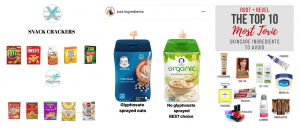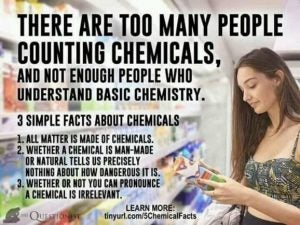Wellness influencers who promote health and wellness products via various social media platforms can be pretty easy to spot, as they often have one or more of these common phrases in their bio and/or throughout their posts: “toxin free,” “low tox,” “clean beauty,” “clean living,” and even “chemical free” in some cases. The purpose of these accounts is typically to sell “cleaner” or more “natural” products, but they don’t achieve that just by highlighting the merits of the actual product. They create a need for “clean,” “toxin free” and/or “natural” products by scaring consumers into believing that the alternatives are less safe, or even toxic.
I’ll start by showing just a few examples of how wellness influencers tend to grab the attention of their audience by presenting eye catching graphics showing products that they deem “not approved” or “thumbs down” and then a group of “approved” or “thumbs up” products. Sometimes they may just present a list of “toxic” ingredients that they tell you to avoid.

Sometimes there’s no explanation as to why we should avoid the “not approved” products or “toxic” ingredients. In some cases, there are the common appeal-to-nature arguments, implying that the “approved” items are healthier because they’re more natural or safer since there are fewer ingredients or “toxins,” but those are not-evidence based assertions. Some tend to scare consumers about specific food additives or parts per billion levels of specific pesticides residues like the “glyphosate sprayed oats” above. These statements and graphics are missing so much information that would allow the consumer to even begin to determine whether the “approved” or thumbs up products are actually safer than the “not approved” or thumbs down products.
In order to determine if specific products or ingredients are actually at unsafe or toxic levels, the influencers making these claims would need to provide information on what chemicals they’re referring to and at what doses they occur in the product versus a harmful dose. If this information is not cited, then there’s no way that the influencer would even be able to determine if that’s the case. Every chemical has a toxic dose and whether a chemical is natural or synthetic tells you nothing about its safety, so simply claiming that a product is safer because it’s natural or that an ingredient is toxic because it is synthetic or difficult to pronounce ignores basic chemistry and toxicology. These influencers are relying on you to not have an understanding of these basic science concepts.
In many cases, they don’t have that basic knowledge either.
However, even when presented with a science based explanation and evidence showing that their claims ignore basic science, many of these influencers decide to double down on their fear-based marketing tactics and label those that are trying to inform them as “industry shills” or simply, “haters.” That is what is called an ad hominem fallacy and is used to deflect the conversation away from the actual topic in an attempt to undermine the other person’s argument.
These influencers are using the same psychology that adults will sometimes use on children. “Better go to sleep or the boogeyman will get you!” I mean, sure, this may work to some extent to get your child to go to sleep, but are you teaching them the importance of sleep? Will they be more anxious because they’re now afraid if they don’t fall asleep in time?
If consumers are legitimately scared of eating certain ingredients and foods because of false information, could it lead them to eating a healthier diet? It certainly could, but it can also increase anxiety based off of unnecessary food fears. Perhaps more importantly, it’s not actually teaching them anything about food or nutrition. They’ve learned nothing about nutrition if they think that they need to be avoiding specific foods purely based on the fact that an influencer has deemed them “toxic” or given them a thumbs down. In fact, now they may be more apt to believe other foods and products are “toxic” based on the same false reasoning they learned from the wellness influencer rather than applying basic science concepts to make an evidence-based determination.
This isn’t benign misinformation either. These false claims and fear-based marketing tactics can have real life negative effects, especially on low income populations that can’t afford the “clean” or “toxin free” alternatives. They may assume that a healthy diet just isn’t attainable for them or even that produce is toxic if it’s not organic. Peer-reviewed research shows fear-based messaging tactics that invoke safety concerns about non-organic produce may be having a negative impact on consumption of fruits and veggies among low income consumers. Another peer-reviewed study by John Hopkins University’s Center for a Livable Future found conflicting health and safety messages, including those about pesticide residues, were having a negative impact on consumers. Among their findings and recommendations: “The issue of organic can swamp or compete with other messages about nutrition, as evidenced by the data presented here. Perceiving that there is an overwhelming amount of sometimes contradictory information about healthy eating could make some consumers defeatist about trying to eat healthily.”
So, where does that leave the average consumer that is being bombarded by this fear-based messaging surrounding food? Not everyone has the same education or understanding of science, and that’s fine. It’s not necessary to have even taken a chemistry or toxicology course in order to understand some of these basic science concepts that can help you to spot misinformation and pseudoscience. I wrote about some of these basic science concepts here. This article outlines a few more simple chemistry facts that can help you to spot fear based marketing claims, and both of these articles have some great introductory information on basic toxicology concepts and how they relate to pesticide residues on foods. These two free online courses are excellent as well. I’ve taken them both myself and found the science literacy course to be particularly helpful.
It’s never too late to begin making your food purchasing decisions based on facts rather than fears and to unfollow toxic wellness influencers.

Food Science Babe is the pseudonym of an agvocate and writer who focuses specifically on the science behind our food. She has a degree in chemical engineering and has worked in the food industry for more than decade, both in the conventional and in the natural/organic sectors.



